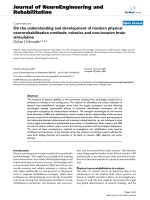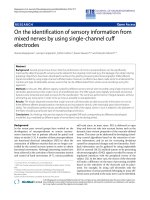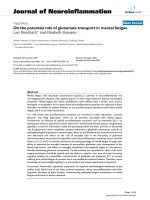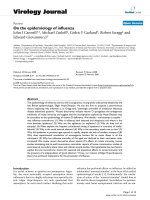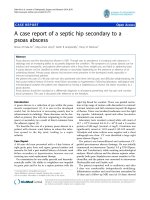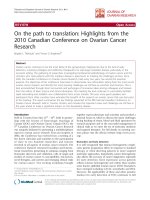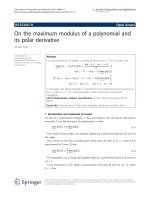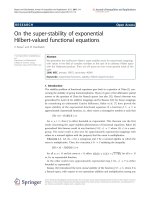Báo cáo hóa học: " On the nature of the stretched exponential photoluminescence decay for silicon nanocrystals" doc
Bạn đang xem bản rút gọn của tài liệu. Xem và tải ngay bản đầy đủ của tài liệu tại đây (1.46 MB, 8 trang )
NANO EXPRESS Open Access
On the nature of the stretched exponential
photoluminescence decay for silicon nanocrystals
G Zatryb
1
, A Podhorodecki
1*
, J Misiewicz
1
, J Cardin
2
, F Gourbilleau
2
Abstract
The influence of hydrogen rate on optical properties of silicon nanocrystals deposited by sputtering method was
studied by means of time-resolved photoluminescence spectroscopy as well as transmission and reflec tion
measurements. It was found that photoluminescence decay is strongly non-single exponential and can be
described by the stretched exponential function. It was also shown that effe ctive decay rate probability density
function may be recovered by means of Stehfest algorithm. Moreover, it was proposed that the observed
broadening of obtained decay rate distributions reflects the disorder in the samples.
Introduction
The discovery of visible photoluminescence (PL) from
porous silicon and then silicon nanocrystals (Si-NCs)
has stimulated a great deal of interest in this material
mainly due to a number of promising potential applica-
tions, like, for instance, light emitting diodes [1] or sili-
con-based lasers [2]. Although the quantum efficiency of
Si-NCs emission gives hope for future device applica-
tions, it remains low compared to the direct band gap
III-V or II-VI materials. It is partially due to technologi-
cal problems with fabric ation of defect-free and structu-
rally uniform Si-NCs samples, where nonradiative
recombination s ites do not play a key role in the emis-
sion process. From this point of view, the improvement
of Si-NCs emission quantum efficiency remains an
important challenge for further optoelectronic applica-
tions. Thus, any experimental tool that leads to informa-
tion about non-uniformity of Si-NCs structures and it s
influence on emission properties is valuable.
The optical properties of Si-NCs can be investigated
by means of time-re solved spectroscopy. This method
often brings new information about disorder in the
ensembles of emitters, especially in complex systems
where various collective phenomena result in compli-
cated time dependence of t he experimental PL decay.
Particula rly, in the case of Si-NCs different authors have
shown [3,4] that very often PL decay exhibits stretched
exponential line shape. However, the physical origin of
such behavior remains a matter of discussion. For this
moment, a few explanations have been given by differ-
ent authors, such as e xciton migration between inter-
connected nanocrystals [5], variation of the atomic
structure of Si-NCs o f different sizes [6], carriers out
tunneling from Si-NCs to distribution of nonradiative
recombination traps [7] and many other [8,9]. There-
fore, it is still important to gather some new experimen-
tal evidence in this field.
It should be also emphasized that in the case of
stretched exponent ial relaxat ion function, the PL decay
may be analyzed more thoroughly by recovering the distri-
bution of recombination rates [10]. Surprisingly, this kind
of approach is very rare with Si-NCs, especially for struc-
tures deposited by the sputtering method. Very few papers
report on recombination rate distributions calculated by
means of inverse Laplace transform [7] for porous sili con
or by means of the maximum entropy method for Si-NCs
produced by laser pyrolysis of silane [11]. There fore, it is
worth investigating the evolution of such distributions also
in the case of other deposition methods.
In this work, we study t he absorption properties as
well as PL decays measured for Si-NCs thin films depos-
ited by the magnetron sputtering method. It is shown
that time dependence of PL may be described by the
stretched exponential function. The distributions of
recombination rates are calculated numerically by
means of inverse Laplace transform. The influence of
structural disorder on carrier relaxation kinetics is
discussed.
* Correspondence:
1
Institute of Physics, Wroclaw University of Technology, Wybrzeze
Wyspianskiego 27, 50-370 Wroclaw, Poland
Full list of author information is available at the end of the article
Zatryb et al. Nanoscale Research Letters 2011, 6:106
/>© 2011 Zatryb et al; licensee Springer. This is an Open Access article distributed under the terms of the Creative Commons Attr ibution
License (http://creat ivecommons.org/licenses/by/2.0), which permits unrestricted use, distribution, and reprod uction in any medium,
provided the original work is properly cited.
Experimental details
The silicon-rich-silicon oxide (SRSO) films with a nom-
inal thickness of 500 nm used for this study were depos-
ited onto quartz substrates by radio-frequency reactive
magnetron sputtering. The incorporation of Si excess
was monitored through the variation of the hydrogen
rate r
H
= P
H2
/(P
Ar
+ P
H2
) from 10% to 50%. The films
were deposited without any intentional heating of the
substrates and with a power density of 0.75 W/cm
2
.All
samples were subsequently annealed at 1,100°C for 1 h
under N
2
flux in o rder to favor the precipita tion of Si
excess and to induce Si-NCs formation.
The absorption properties were investigated by means of
transmission and absorption measurements (with mixed
xenon and halogen light sources). Time-resolved photolu-
minescence spectra were investigated by means of strobe
technique with pulsed xenon lamp used as an excitation
source and photomultiplier tube (PMT) used for detec-
tion. For the excitation wavelength used in our experiment
(350 nm) the pulse width at half maximum was about 2
μs. To calculate the inverse La place transform for decay
rates recovery , numerical cal culations wer e performed
using Stehfest algorithm [12] (for N =14).
Results and discussion
In our previous papers [13,14] detailed structural inves-
tigations (including atomic force microscopy, X-ray dif-
fraction, high-resolution electron microscopy or
Rutherford backscattering) of SRSO films fabricated
with the same technological conditions have been
reported. The main conclusion of these investigations
has shown that the increase of r
H
used during depo si-
tion leads to i ncreased disorder in the sample. Namely,
deposition with r
H
= 10% favors formation of well-crys-
tallized Si-NCs with average size of about 3 nm, whereas
deposition with r
H
= 50% favors formation of mostly
amorphous Si nanograins with size less than 2 nm.
Figure 1 shows time-resolved PL spectra measured for
samples with r
H
= 10%, 30% and 50%. In each case, the
broad emission band centered at around 1.5 eV may be
observed (the nonsymmetrical emission band shape is
due to the cut-off of PMT detector). What is more, the
PL intensity significantly drops after increasing r
H
from
10% to 30% and then decreases only slightly. The lack
of PL shift with r
H
var iat ion indicates that the obs erved
emission rather cannot be attributed to the quantum
confinement effect. It may, however, be attributed to
some emission centers at the interface between Si-NCs
and SiO
2
matrix (surface states) because according to
what has be en shown [15], defect states localized on the
nanocrystal surface may suppress the quant um confine-
ment effect on the emission spectra. Similar effect has
also been observed in one of our pre vious papers [16]
for Si-NCs.
Figure 2 shows the absorption (a) spectra calculated
from reflectance (R) and transmittance (T)measure-
ments according to the equation a ∝ -ln(T /(1 - R)
2
)
which allows us to deal with disturbing interference pat-
terns [17]. For the higher energy part of the spectra, the
Tauc formula (aE)=A(E - E
g
)
m
was used to estimate
the optical band gap (E
g
). The best fit to the experimen-
tal data was obtained for m = 1/2, which corresponds to
direct allowed t ransition. It may a lso be noted th at the
absorption edge is significantly blue-shifted from 3.76
eV for r
H
= 10% to 4.21 eV for r
H
= 50%. The observed
blue-shift of absorption edge may be related to quantum
confinement effect which w as discussed by us in more
details elsewhere [16].
What is more, below the optical band gap, the spec-
tra shown in Figure 2 reveal long, exponentially
decreasing absorption edges. Assuming that these
absorption tails have amorphous nature [18] related to
the structural non-uniformityofsamples,theycanbe
approximately described by Urbach equation: a = C
exp(E/E
U
), where E
U
is the characteristic Urbach
energy determining the exponential slope. Figure 2
clearly shows that E
U
increases with increasing r
H
,
being of the order o f hundreds of millielectron volt.
Longer tails in the absorption edge for higher r
H
con-
stitute another experimental evidence for stronger dis-
order i n samples with higher r
H
.
To analyze the influence of structural disorder on
emitters relaxation kinetic, we introduce a time-domain
relaxation function that describes how system returns to
equilibrium after a perturbation. Namely, after light illu-
mination we obtain some number of emitters n(0) in
the excited state. When we turn off the illumination the
system returns to equilibrium after some time. Thus,
our relaxation function may be defined as time-depen-
dent excited emitters fraction n(t)/n(0).
It is well known [19] that for an ensemble of emi tters,
the relaxation function may be described by Laplace
transform of some non-negative function F(k):
nt
n
kt k dk
0
0
exp
(1)
In Equation 1, the function F(k) may be interpreted as
an effective decay rate probability density function.
Therefore, the decay rate k is in fact a positive random
variable. It can be shown [20] that if relaxation of the
excited emitters to the ground state may o ccur through
many competing channels (for e xample the excited
Zatryb et al. Nanoscale Research Letters 2011, 6:106
/>Page 2 of 8
carriers may escape from nanocrystal to many different
radiative or nonradiative centers), the relaxation func-
tion is given by stretched-exponential (Kohlrausch)
function:
nt
n
t
0
0
exp
(2)
where τ
0
is an effective time constant and b is a con-
stant between 0 and 1.
However, in our experiment we do not measure the
relaxation function directly. Instead, we measure the
number of photons N
Ph
emitted in a very short time
period δt after the excitation pulse. Using a delay gate
generator, we swe ep the delay between moment of mea-
surement and the excitation pulse, creating the PL
decay curve. Because N
Ph
is directly proportional to the
change of excited emitters number Δn = n(t’ +δt)-n(t’),
we may define the decay of PL intensity as a negative
time derivative of the relaxation function:
It
n
dn t
dt
PL
1
0
(3)
Equation 3 is in fact a definition of the so called
response function which determines the rate at which
the relaxation function changes. Thus, in our case, the
adequate form of the stretched-exponential functio n for
PL decay is:
ItCt
t
PL
1
0
exp
(4)
where C is a constant.
Figure 1 The time-resolved PL measured for samples with variou s r
H
(10%, 30% and 50%). The nons ymmetrical emission band shape is
due to the cutoff of PMT detector.
Zatryb et al. Nanoscale Research Letters 2011, 6:106
/>Page 3 of 8
It is also worth noting that Eq. 3 and Eq. 1 imply a
more general relation between F(k) function and PL
decay, namely:
It
d
dt
kt k dk
PL
exp
0
(5)
which in turn leads to the following expression:
It k kt kdk
PL
exp
0
(6)
We would like to emphasize that Eq. 6 may be used
to model many kinds of non-single exponential PL
decays. This is an important issue, since in many
papers the photoluminescence decay curve, measured
in a similar way as described in t he text, is modeled
with the time dependence of Eq. 1. While this is a very
good method to quantitative ly describe the extent to
which the decay is non-single exponential, it does not
provide direct informati on about the F(k) probabilit y
density function.
Figure 3 shows experimental PL decays measured at
around 820 nm (PL peak, 1.5 eV). Hundreds-microse-
conds long, strongly non-single exponential decay pro-
files were obtained that can be well described by Eq. 4.
The least-squares fit of the Eq. 4 to experimental data
brings values of τ
0
and b. Having both constants, it is
possible to define ave rage decay time constant <τ>in
the following form:
0
1
(7)
where Γ is the Gamma function.
In the i nvestigated case, it was found that the b constants
were equal to 0 .68, 0.57, 0.55 for r
H
= 10%, 30%, 50%,
respectively. The average decay times <τ>(andτ
0
)were
equal to 70 μs(τ
0
≈ 54 μs), 48 μs(τ
0
≈ 30 μs) and 36 μs
( τ
0
≈ 21 μs) for r
H
= 10%, 30%, 50%, respectively. Both
Figure 2 Absorption spectra calculated on the basis of the reflectance and t ransmittance measurements.Theleft axis shows long
exponential tails in the absorption edge. The right axis shows curves used for estimating the band gap according to the Tauc formula. The blue-
shift of the absorption edge may be observed with increasing r
H
.
Zatryb et al. Nanoscale Research Letters 2011, 6:106
/>Page 4 of 8
parameters decrease with increasing r
H
.Moreover,the
values of b and τ remain close to a lready reported
results [21].
To analyze stretched exponential behavior in more
details, we may recover the decay rates probability den-
sity function F(k). Using an analytical expression, such
as Eq. 2 with b and τ
0
taken from the experimental data
fit to Eq. 4, it is possible to recover F(k)bymeansof
inverse Laplace transform, solving the following equation:
L
nt
n
k
1
0
(8)
Obviously, the Eq. 7 solution depends on n(t)/n(0)
function. In particular, for n(t)/n(0) given by Eq. 2, there
is no general analytical solution and only asymptotic
form of F(k) distribution may be obtained by the sad-
dle-point method [22]:
k
a
kk
aa
2
12/
exp
(9)
where a = b(1 - b)
-1
and τ = τ
0
[b(1-b)
1/a
]
-1
.
Alternatively, the inversion of Laplace transform (Eq.
8) may be computed numerically using Stehfest algo-
rithm [12]. By comparing the numerical inversion of Eq.
8 with Eq. 9, we obtained the same result s for F(k)dis-
tribution. In this way, we have found very good Stehfest
algorithm accuracy for this class of f unctions. This last
resultmaybeimportantinacasewhenn(t)/n(0) func-
tion is a bit different than stretched-exponential, calcu-
lations with Stehfest algo rithm shoul d bring good
results.
Figures 4a,b show decay rate distribution F(k)calcu-
lated from Eq. 8. As e xpected, a power-like depe ndence
may be observed (Figure 4a) for high values of the
abscissa variable. The obtained distributions are very
Figure 3 The non-single exponential PL decays measured for samples with different r
H
.Thesolid line stands for stretched exponential
function fit (Eq. 1). b parameters and the average time constant <τ> are shown.
Zatryb et al. Nanoscale Research Letters 2011, 6:106
/>Page 5 of 8
Figure 4 Effective dec ay rate probability density functions. Power-like dependence may be observed for higher decay rates (a) in log-log
scale. The distribution broaden significantly with the increase of r
H
. Shift of the distribution is visible (b) together with average decay time drop
and E
U
rise for higher r
H
(inset). The normalization in (b) was carried out in a manner exposing distributions broadening while in (a) the function
F(k) is properly normalized probability density function.
Zatryb et al. Nanoscale Research Letters 2011, 6:106
/>Page 6 of 8
broad with long tails directed towards shorter lifetimes,
which dem onstrates the strongly non-single exponential
character of decay curves. While increasing r
H
,the
decay rate d istribut ion F(k) shifts towards higher decay
rates (Figure 4b). What is more, F(k) broaden signifi-
cantly with increasing r
H
parameter.
To explain the observed features, it should first be
mentioned that the obtained F(k)functionprovide
information about both the radiative (k
R
) and nonr adia-
tive (k
NR
) relaxation rates [10]. However, a very low
quantum efficiency of Si-NCs emission suggests that
nonradiative processes should be predominant (k
NR
>>k
R
). This allows us to relate the changes observed in
the decay rate distribution F(k) to the introduction of
more defect states to the matrix containing Si-NCs after
increasing the r
H
factor. These new states may act as
nonradiative recombination paths for the excited car-
riers [7], leading to broadening of F(k)functionand
shortening of the average decay time (Figure 4b).
It is noteworthy that the above interpretation is also
consistent with the rest of experimental results. As it
was mentioned at the beginning, increasing r
H
results in
higher structural disorder, which, in turn, may be the
reason behind the appearance of new nonradiative states
and the simultaneous increase of the Urbach energy E
U
(see the inset to Figure 4b). What is more, this interpre-
tation may be also supported by our recent results [23]
obtained for multilayered S RSO films with Si-NCs. In
this work, we investigated samples with constant Si-NCs
size co-doped with different amounts of boron. We have
found that introductio n of these impurities to Si-NCs
environment leads to stronger deviation from single-
exponential PL decays, which was interpreted as a result
of appearance of new nonradiative sites. This result also
correlates to the model proposed by Suemoto et al. [24],
where broad distributions of decay rates were inter-
preted as a result of different potential barriers for car-
riers out-tunneling from Si-NCs to nonradiative sites.
On the other hand, it has been shown [25] that excita-
tion may migrate from nanocrystals to light-emission
centers , such as S = O bonds. Thus, if probability of such
migration depends on nanocrystal structure (si ze or crys-
tallinity), it is also possib le that radi ative recombination
centers responsible for emission at 1.5 eV have a broad
k
R
distribution (because, as structural results have shown,
size and crystallinity changes with r
H
). Theref ore, if k
R
was comparable with k
NR
then the shape of F(k) function
couldbeinfluencedsomewhatbythek
R
distribution.
This should be especially important for samples with
high quantum effici ency of Si-NCs emission (w here k
NR
<<k
R
or both rates are comparable), which is not the
case. Ne vertheless, it is worth noting that in such case , it
is also possibl e to obtain a broad F(k ) probability density
function and stretched-exponential PL decay.
Conclusions
To sum up, it has been shown that PL decay of Si-NCs
is strongly non-single exponential and may be described
by stretched exponential function. It has been demon-
strated that effective decay rate probability density func-
tion may be recovered with very good accuracy by
means o f numerical inversion of the Laplace transform
(using Stehfest algorithm) as well as using asymptotic
function. In this way, broad d ecay rate distributions
were obtained. It has been proposed that the observed
broadening of the distributions and the decrease of aver-
age decay time constant for higher r
H
factorsisrelated
to the appearance of more nonradiative states in the Si-
NCs environment.
Acknowledgements
The authors would like to offer their sincere gratitude to Prof. K. Weron for
her valuable insight into the theoretical explanation of the relaxation
processes. What is more, A. P. would like to acknowledge for financial
support to Iuventus Plus program (no. IP2010032570).
Author details
1
Institute of Physics, Wroclaw University of Technology, Wybrzeze
Wyspianskiego 27, 50-370 Wroclaw, Poland
2
CIMAP, UMR CNRS/CEA/
ENSICAEN/UCBN, Ensicaen 6 Bd Maréchal Juin, 14050 Caen Cedex 4, France
Authors’ contributions
GZ, AP and JM carried out the spectroscopic measurements as well as
calculations. JC and FG designed and deposited the investigated samples.
All authors read and approved the final manuscript.
Competing interests
The authors declare that they have no competing interests.
Received: 19 September 2010 Accepted: 31 January 2011
Published: 31 January 2011
References
1. Creazzo T, Redding B, Marchena E, Murakowski J, Prather DW: Pulsed
pumping of silicon nanocrystals light emitting devices. Opt Exp 2010,
18:41092.
2. Jalali B, Fathpour S: Silicon photonics. J Lightwave Technol 2006,
24(12):4600-4615.
3. Dovrat M, Goshen Y, Jedrzejewski J, Balberg I, Sa’ ar A: Radiative
versus nonradiative decay processes in silicon nanocrystals probed
by time-resolved photoluminescence spectroscopy. Ph ys Rev B
2004, 69:155311.
4. Walters RJ, Kalkman J, Polman A, Atwater HA, de Dood MJA:
Photoluminescence quantum efficiency of dense silicon nanocrystals
ensembles in SiO
2
. Phys RevB 2006, 73:132302.
5. Pavesi L: Influence of dispersive exciton motion on the recombination
dynamics in porous silicon. J Appl Phys 1996, 80:216.
6. Guillois O, Herlin-Boime N, Reynaud C, Ledoux G, Huisken F:
Photoluminescence decay dynamics of noninteracting silicon
nanocrystals. J Appl Phys 2004, 95:3677.
7. Mihalcescu I, Vial JC, Romestain R: Carrier localization in porous silicon
investigated by time-resolved luminescence analysis. J Appl Phys 1996,
80:2404.
8. Sawada S, Hamada N, Ookubo N: Mechanisms of visible
photoluminescence in porous silicon. Phys Rev B 1994, 49:5236.
9. Linnros J, Lalic N, Galeckas A, Grivickas V: Analysis of the stretched
exponential photoluminescence decay from nanometer-sized silicon
crystals in SiO
2
. J Appl Phys 1999, 86:6128.
10. van Driel AF, Nikolaev IS, Vergeer P, Lodahl P, Vanmaekelbergh D, Vos WL:
Statistical analysis of time-resolved emission from ensembles of
Zatryb et al. Nanoscale Research Letters 2011, 6:106
/>Page 7 of 8
semiconductor quantum dots: interpretation of exponential decay
models. Phys Rev B 2007, 75:035329.
11. Delerue C, Allan G, Reynaud C, Guillois O, Ledoux G, Huisken F:
Multiexponential photoluminescence decay in indirect-gap
semiconductor nanocrystals. Phys Rev B 2006, 73:235318.
12. Stehfest H: Algorithm 368 Numerical inversion of Laplace Transforms.
Commun ACM 1970, 13:47.
13. Ternon C, Gourbilleau F, Portier X, Voidevel P, Dufour C: An original
approach for the fabrication of Si/SiO
2
multilayers using reactive
magnetron sputtering. Thin Solid Films 2002, 419:5.
14. Gourbilleau F, Levalois M, Dufour C, Vicens J, Rizk R: Optimized conditions
for an enhanced coupling rate between Er ions and Si nanoclusters for
an improved 1.54-μm emission. J Appl Phys 2004, 95:3717.
15. Wolkin MV, Jorne J, Fauchet PM, Allan G, Delerue C: Electronic states and
luminescence in porous silicon quantum dots: the role of oxygen. Phys
Rev Lett 1999, 82:197.
16. Podhorodecki A, Misiewicz J, Gourbilleau F, Rizk R: Absorption mechanisms
of silicon nanocrystals obtained at different hydrogen partial pressure in
co-sputtered (SRSO) film. Electrochemical Solid State Letters 2008, 11:K31.
17. Podhorodecki A, Zatryb G, Misiewicz J, Wojcik J, Mascher P: Influence of
the annealing temperature and silicon concentration on the absorption
and emission properties of Si nanocrystals. J Appl Phys 2007, 102:043104.
18. Mishra P, Jain KP: Raman, photoluminescence and optical absorption
studies on nanocrystalline silicon. Mat Sc Eng B 2002, 95:202.
19. Milovanov AV, Rypdal K, Rasmussen JJ: Stretched exponential relaxation
and ac universality In disordered dielectrics. Phys Rev B 2007, 76:104201.
20. Klafter J, Shlesinger MF: On the relationship among Tyree theories of
relaxation In disordered systems. Proc Natl Acad Sci 1986, 83:848.
21. Cho EC, Green MA, Conibeer G, Song D, Cho YH, Scardera G, Huang S,
Park S, Hao XJ, Huang Y, Van Dao L: Silicon Quantum Dots In a Dielectric
Matrix for All-Silicon Tandem Solar Cells. Adv OptoElectron 2007, 69578.
22. Saito R, Murayama K: A universal distribution function of relaxation in
amorphous materials. Solid State Commun 1987, 63:625.
23. Zatryb G, Podhorodecki A, Hao XJ, Misiewicz J, Shen YS, Green MA:
Quantitative evaluation of boron-induced disorder in multilayered
matrix containing silicon nanocrystals designed for photovoltaic
applications. Optics Express 2010, 18:22004.
24. Suemoto T, Tanaka K, Nakajima A: Interpretation of the temperature
dependence of the luminescencje intensity, life time, and decay profiles
In Poros Si. Phys Rev B 1994, 49:11005.
25. Khriachtchev L, Nikitin T, Velagapudi R, Lahtinen J, Novikov S: Light-
emission mechanizm of thermally annealed silicon-rich silicon oxide
revisited: What is the role of silicon nanocrystals. Appl Phys Lett 2009,
94:043115.
doi:10.1186/1556-276X-6-106
Cite this article as: Zatryb et al.: On the nature of the stretched
exponential photoluminescence decay for silicon nanocrystals.
Nanoscale Research Letters 2011 6:106.
Submit your manuscript to a
journal and benefi t from:
7 Convenient online submission
7 Rigorous peer review
7 Immediate publication on acceptance
7 Open access: articles freely available online
7 High visibility within the fi eld
7 Retaining the copyright to your article
Submit your next manuscript at 7 springeropen.com
Zatryb et al. Nanoscale Research Letters 2011, 6:106
/>Page 8 of 8
